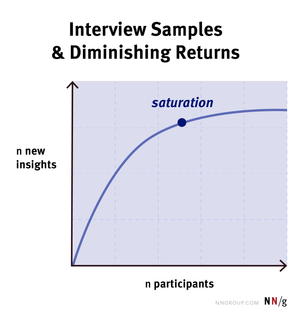Research
1. Empathize
Conduct user research to uncover genuine pain points and user needs that are not met.
Plan user research
Plan should have:
- Project background
- Establish overarching research goals (clarify specific ideas to learn or outcomes to achieve)
- Decide what to conduct:
- User interviews (shows contextual relationships between data points)
- Fly on the wall (observe without interferring)
- Quantitative surveys (big data that gives spread of numbers)
- Identify who's affected by design
- Define deliverables that research should yield
- Ensure quality of research data
- Determine KPIs to measure in study (Time on task, Use of navigation vs. search, User error rates, Drop-off rates, Conversion rates, System Usability Scale, Net Promoter Score
Recruit Participants
- Recruit a diverse participant pool
- Develop a set of criteria that will ensure you select interviewees who are best suited to meet objectives of your interview.
- Find people from existing user base, online, hallway testing
- Get 5-8 people per user group/persona you are studying, but reduce this if you have budget/timeline constraints (this is only the start after all)
- Consider giving incentives

Conduct Interviews
- Prepare for interviews
- Script interview questions
- Collect supplies (e.g. laptop, printed questions, markers)
- Email interviewees for 1-1 interviews as far as possible
- Book conducive spaces and travel to their location if it's best
- Remind them of interviews
- Conduct interviews
- Thank users for coming, gather basic details, ask permission to record
- Speak clearly & concisely, remain professional. Be active listener - nod, make appropriate eye contact, write notes
- Ask open-ended questions, start with “why” questions.
- If given short “yes” or “no” answer, ask neutral follow-up question to get them to share more.
- Take notes, highlight compelling quotes, write down observations about participants, record interviews
- Thank participants after we're done
2. Define
Analyze research from empathize phase to identify and prioritize key user problems that need solving, explaining rationale behind these priorities.
Write User Stories
User stories are “checklists” to ensure we address and solve key problems they might face with product.
- User stories concisely capture user needs
- User stories prioritize design goals
- User stories foster user-centric empathy
- User stories justify decisions by showcasing user benefits
- Craft user stories to be succinct yet impactful
- User stories should have clear action and benefit
- Create one-sentence narratives from a persona’s viewpoint that define who user is, what they want to accomplish, and why.
Example
As [type of user], I want to [action] so that [benefit].
Draw User Journeys
Write user journeys for your users:
- Draw sequence of experiences a user undergoes in attempting to achieve their goal.
- Think about user pain points. Are they because of financial, product, process, customer support pains?
- After you define pain points, answer Who, What, When, Where, Why, and How to solve problems.
Problem Statement
Formulate clear problem statement and develop value proposition:
- Summarize who user is, what they need from design, and why
- Ensure design caters to various user types by crafting problem statements for each user persona, thus aligning product development with diverse user needs.
Example
[Name of user persona] is a [type of user] who needs [type of user experience] because [benefits of user experience].
3. Ideate
Think of something.
Develop Hypotheses
- Create hypothesis statements on what solution might be.
- Use "How Might We". Good HMW accommodates many solutions, but keep focused on these solutions.
- Or use it in a we believe format:
- Ensure hypothesis statements establish what user can do/achieve, what desired outcome that we call successful
Example
If [action], then [outcome]
Example
We believe that [action] will [outcome].
Come Up With Design Solutions
Generate many ideas without judging quality.
- Transform problem statement into "How might we" questions.
- Rapid sketching: Divide a sheet into squares (8), sketch ideas anything (even crazy stuff), keep to timed intervals.
- Do competitive audits to analyze competitors' products, strengths, & weaknesses.
- Applying SCAMPER method: Substitute, combine, adapt, modify, put to another use, eliminate, & rearrange elements.
Assess Feasibility
- Assess ideas based on feasibility within budget and schedule constraints and alignment with design standards.
- Determine if design idea has value - what does it do and why should users care?
4. Prototype & Test
Make something.
Prototype
Create an initial model of a product that showcases its features and allows for testing:
- Develop a sitemap to organize product by defining its hierarchy and sequence, illustrating topics' importance and navigational flow.
- Produce wireframes, both paper-based and digital (using tools like Figma or Adobe XD), to visually represent product's layout and interface.
- Construct low-fidelity prototypes to provide a basic interactive model of product, allowing for initial user interaction feedback.
- Advance to high-fidelity prototypes that closely mimic final product with detailed components and interactivity for thorough testing.
Test
- Integrate testing throughout prototyping phase to refine design continuously based on user feedback:
- Begin with simple sketches or sitemaps to gather initial feedback.
- Progress to more detailed paper prototypes for another testing round.
- Further iterate to a high-fidelity, interactive model for additional user testing.
- Potentially test multiple prototypes or same prototype across different devices to optimize user experience.
- Establish a comprehensive testing plan to refine prototype effectively:
- Determine who will participate in tests, from informal feedback circles to target users.
- Define what types of tests will be conducted, considering both prototype's stage and testing environment.
- Clarify why tests are conducted, primarily to validate earlier design decisions and uncover usability issues.
- Outline how participants will interact with prototype and how information will be collected during tests, ensuring inclusivity and accessibility.